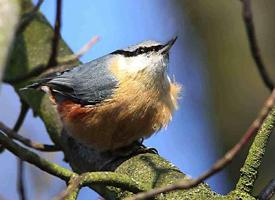
Súlyok és méretek
| Hossz | 13-tól 14,5-ig cm |
|---|---|
| Súly | 23 g |
| Szárnyfesztávolság | 23-tól 27-ig cm |
Állatleírás
The Eurasian Nuthatch, scientifically named Sitta europaea, is a captivating small passerine bird that graces the woodlands of Europe and parts of Asia with its presence. This species is particularly noted for its unique physical and behavioral characteristics, which distinguish it from other members of the avian world.One of the most striking features of the Eurasian Nuthatch is its appearance. The bird exhibits a compact body that typically measures between 12 to 14.5 centimeters in length, making it a relatively small yet robust bird. Its plumage is a delightful mix of colors that blend seamlessly with the forest environments it inhabits. The upper parts of its body are predominantly covered in a soft, blue-grey color, which contrasts beautifully against the rich, chestnut hues found on its underparts. A distinguishing characteristic of its appearance is the black eye stripe that extends through its eye, creating a masked effect that is both striking and endearing. The nuthatch's short, powerful bill is perfectly adapted for its feeding habits, enabling it to crack open nuts and seeds with remarkable efficiency.
Behaviorally, the Eurasian Nuthatch exhibits several fascinating traits. It is renowned for its agility and acrobatic skills, often seen scaling tree trunks and branches in search of food, moving with ease in all directions - even headfirst down a tree, a feat not commonly observed in other bird species. This adept climber is also known for its unique habit of using small cracks and crevices in trees to store food, such as seeds and nuts, which it meticulously prepares by wedging them into tight spaces and hammering them open with its strong beak.
The diet of the Eurasian Nuthatch primarily consists of insects and seeds, making it an essential player in the control of insect populations and the dispersal of seeds in its ecosystem. During the breeding season, which typically occurs from April to June, the nuthatch demonstrates another peculiar behavior - it plasters mud around the entrance of its chosen nesting site, usually a hole in a tree, to reduce the size of the entrance. This ingenious strategy helps protect the nest from potential predators and competition.
The vocalizations of the Eurasian Nuthatch are equally interesting, comprising a variety of calls and songs that include a sharp "tuit" sound and a melodic whistle. These sounds serve various purposes, from attracting mates to signaling alarm.
In terms of habitat, the Eurasian Nuthatch is quite versatile, inhabiting deciduous and mixed woodlands, parks, and gardens. It shows a preference for mature forests with a plentiful supply of old trees, which provide both food and nesting sites. Despite facing threats from habitat loss and fragmentation in certain areas, the species remains widespread and is not currently considered to be at significant risk.
In conclusion, the Eurasian Nuthatch is a remarkable bird, both in appearance and behavior. Its adaptability, combined with its striking looks and intriguing habits, make it a cherished species among birdwatchers and nature enthusiasts alike. As it continues to navigate the challenges of its changing environment, the Eurasian Nuthatch remains a symbol of the resilience and beauty of the natural world.
Új állatfotók
Top 10 állat
- Diana monkey (Cercopithecus diana)
- Dolphin gull (Leucophaeus scoresbii)
- Moustached guenon (Cercopithecus cephus)
- Galápagos tortoise (Geochelone nigra complex)
- Stone loach (Barbatula barbatula)
- Common house mosquito (Culex pipiens)
- Japanese spider crab (Macrocheira kaempferi)
- Colossal squid (Mesonychoteuthis hamiltoni)
- Common reed warbler (Acrocephalus scirpaceus)
- Sea urchins (Echinoidea)